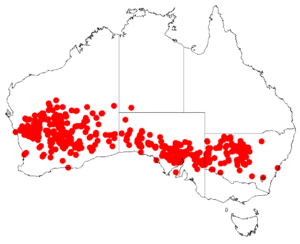Burkitt's wattle facts for kids
Quick facts for kids Burkitt's wattle |
|
|---|---|
| Scientific classification | |
| Genus: |
Acacia
|
| Species: |
burkittii
|
 |
|
| Occurrence data from AVH | |
Acacia burkittii is a type of wattle plant. It is a shrub that grows year after year. You can find it in the dry areas of Western Australia, South Australia, and western New South Wales. It belongs to the pea family, called Fabaceae.
People have many names for this plant. Some common names are Burkitt's wattle, fine leaf jam, gunderbluey, pin bush, and sandhill wattle. This plant has also been introduced to India.
Scientists used to think Acacia burkittii was a subspecies of another plant, Acacia acuminata. But now they know it is its own unique species. It often grows in woodlands or shrublands, especially on sandhills.
What it Looks Like
Burkitt's wattle is usually a straight or spreading shrub. It can grow from 1 to 4 meters tall, and sometimes even taller. Its bark is dark brown and has small cracks. The branches are round and smooth.
Its leaves are actually not true leaves. They are flattened leaf stems called phyllodes. These phyllodes are straight or slightly curved. They are long, about 5 to 16 centimeters, and very thin, like a needle. They often have fine hairs along their edges. The tip of the phyllode is usually pointed and curved.
The flowers grow in groups of two or three where the phyllodes join the stem. These flower clusters are round or cylinder-shaped. They are bright yellow and about 0.5 to 1.5 centimeters long. Each flower usually has four parts.
After flowering, the plant produces seed pods. These pods are slightly curved and look like a string of beads. They are 5 to 12 centimeters long and 5 to 7 millimeters wide. The pods are thin like paper and smooth. Inside, the seeds are lined up lengthwise.
Burkitt's wattle usually flowers from July to October.
How it was Named
The first scientific description of Acacia burkittii was written in 1864. This was done by a scientist named Ferdinand von Mueller. His description was published in a book called Flora Australiensis by George Bentham.
The plant was named after a person named Burkitt. Burkitt found the first sample of this plant near Lake Gilles in South Australia.

